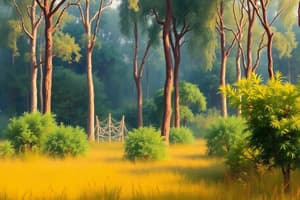Podcast
Questions and Answers
What factors determine the classification of forests into moist and dry deciduous varieties?
What factors determine the classification of forests into moist and dry deciduous varieties?
The classification is based on the availability of water and the amount of rainfall received, specifically rainfall between 200 and 100 cm for moist forests and 100 cm to 70 cm for dry forests.
Name two commercially important trees found in moist deciduous forests.
Name two commercially important trees found in moist deciduous forests.
Teak and mahogany are two commercially important trees found in moist deciduous forests.
Describe the typical height and appearance of trees in moist deciduous forests.
Describe the typical height and appearance of trees in moist deciduous forests.
Trees in moist deciduous forests can reach heights of up to 60 meters and maintain a green appearance throughout the year due to the absence of a definite leaf-shedding time.
List three animal species commonly found in the moist deciduous forests.
List three animal species commonly found in the moist deciduous forests.
What regions in India primarily host dry deciduous forests?
What regions in India primarily host dry deciduous forests?
Which animal species are typically associated with dry deciduous forests?
Which animal species are typically associated with dry deciduous forests?
What is the significance of having a multilayered structure in moist deciduous forests?
What is the significance of having a multilayered structure in moist deciduous forests?
What is the primary use of Sarpagandha in medicinal practices?
What is the primary use of Sarpagandha in medicinal practices?
Which plant's juice is utilized for its carminative and diuretic properties?
Which plant's juice is utilized for its carminative and diuretic properties?
What medicinal benefit does Arjun provide?
What medicinal benefit does Arjun provide?
What are the medical uses of Babool leaves and gum?
What are the medical uses of Babool leaves and gum?
What are the key properties of Neem?
What are the key properties of Neem?
How is Tulsi used in medicine?
How is Tulsi used in medicine?
What conditions is Kachnar known to treat?
What conditions is Kachnar known to treat?
How many medicinal plants are considered critically threatened according to the World Conservation Union's Red List?
How many medicinal plants are considered critically threatened according to the World Conservation Union's Red List?
Identify the regions where elephants are found in India.
Identify the regions where elephants are found in India.
Name the habitat for wild ass and camels in India.
Name the habitat for wild ass and camels in India.
What causes the change in natural vegetation as altitude increases in mountainous areas?
What causes the change in natural vegetation as altitude increases in mountainous areas?
Name three common animals found in Montane forests.
Name three common animals found in Montane forests.
What type of forests are found between 1000 and 2000 metres in mountainous regions?
What type of forests are found between 1000 and 2000 metres in mountainous regions?
What characteristics define mangrove forests?
What characteristics define mangrove forests?
Which animal is famously associated with mangrove forests?
Which animal is famously associated with mangrove forests?
What types of vegetation are found in the Ganga-Brahmaputra delta?
What types of vegetation are found in the Ganga-Brahmaputra delta?
What is the primary reason for different types of forests in India?
What is the primary reason for different types of forests in India?
What would happen to the ecosystem if plants and animals were to disappear?
What would happen to the ecosystem if plants and animals were to disappear?
Which types of trees are commonly found in thorn forests and scrubs?
Which types of trees are commonly found in thorn forests and scrubs?
Why is biodiversity essential for the environment?
Why is biodiversity essential for the environment?
How does altitude affect forest types in India?
How does altitude affect forest types in India?
What role do mud and silt play in mangrove forests?
What role do mud and silt play in mangrove forests?
What kind of vegetation is expected in regions with rainfall between 200 cm and 70 cm?
What kind of vegetation is expected in regions with rainfall between 200 cm and 70 cm?
Which animals could typically be found in thorn forests?
Which animals could typically be found in thorn forests?
List two factors that contribute to the diversity of plant and animal life in specified forests.
List two factors that contribute to the diversity of plant and animal life in specified forests.
What adaptations do plants in thorn forests possess to survive in arid conditions?
What adaptations do plants in thorn forests possess to survive in arid conditions?
Identify some of the important coniferous trees found in high-altitude areas of India.
Identify some of the important coniferous trees found in high-altitude areas of India.
What is the significance of forest cover maps in understanding vegetation distribution?
What is the significance of forest cover maps in understanding vegetation distribution?
What types of vegetation take over as one moves to even higher altitudes beyond 3,600 meters?
What types of vegetation take over as one moves to even higher altitudes beyond 3,600 meters?
What is the primary concern highlighted regarding wildlife in Ladakh's extreme cold?
What is the primary concern highlighted regarding wildlife in Ladakh's extreme cold?
Name two benefits that yaks and other animals provide to the ecosystem and humans.
Name two benefits that yaks and other animals provide to the ecosystem and humans.
What role do insects play in the ecosystem according to the information provided?
What role do insects play in the ecosystem according to the information provided?
How many plant species are reported as endangered, and what impact does this have?
How many plant species are reported as endangered, and what impact does this have?
What are some steps that can be taken to protect endangered species?
What are some steps that can be taken to protect endangered species?
Flashcards
What are tropical rainforests characterized by?
What are tropical rainforests characterized by?
Tropical rainforests are found in areas with high rainfall, typically over 200 cm, and a short dry season. They're characterized by tall trees (up to 60 meters), lush vegetation, and a multilayered canopy. They are evergreen, meaning trees don't shed leaves at a specific time, keeping the forests green all year round.
Where are tropical rainforests found in India?
Where are tropical rainforests found in India?
Tropical rainforests are found in the Western Ghats, Lakshadweep, Andaman and Nicobar islands, upper parts of Assam and the Tamil Nadu coast.
What animals inhabit the tropical rainforests of India?
What animals inhabit the tropical rainforests of India?
Tropical rainforests are home to diverse wildlife, including elephants, monkeys, lemurs, deer, and one-horned rhinoceroses (found in Assam and West Bengal). They also support a variety of birds, bats, sloths, scorpions, and snails.
What are tropical deciduous forests?
What are tropical deciduous forests?
Signup and view all the flashcards
Where are tropical deciduous forests found in India?
Where are tropical deciduous forests found in India?
Signup and view all the flashcards
What animals are found in tropical deciduous forests in India?
What animals are found in tropical deciduous forests in India?
Signup and view all the flashcards
How are tropical deciduous forests further categorized?
How are tropical deciduous forests further categorized?
Signup and view all the flashcards
Tropical Deciduous Forests
Tropical Deciduous Forests
Signup and view all the flashcards
Thorn Forests and Scrubs
Thorn Forests and Scrubs
Signup and view all the flashcards
Temperate Grasslands
Temperate Grasslands
Signup and view all the flashcards
Coniferous Forests
Coniferous Forests
Signup and view all the flashcards
Alpine Vegetation
Alpine Vegetation
Signup and view all the flashcards
Long Roots in Thorn Forests
Long Roots in Thorn Forests
Signup and view all the flashcards
Succulent Stems in Thorn Forests
Succulent Stems in Thorn Forests
Signup and view all the flashcards
Small Leaves in Thorn Forests
Small Leaves in Thorn Forests
Signup and view all the flashcards
Transition from Thorn Forests to Scrubs
Transition from Thorn Forests to Scrubs
Signup and view all the flashcards
What are Montane Forests?
What are Montane Forests?
Signup and view all the flashcards
What types of trees dominate Montane Forests?
What types of trees dominate Montane Forests?
Signup and view all the flashcards
What distinguishes Mangrove Forests?
What distinguishes Mangrove Forests?
Signup and view all the flashcards
Where are Mangrove Forests located in India?
Where are Mangrove Forests located in India?
Signup and view all the flashcards
What kind of tree is found in the Ganga-Brahmaputra delta?
What kind of tree is found in the Ganga-Brahmaputra delta?
Signup and view all the flashcards
What animals inhabit Montane Forests?
What animals inhabit Montane Forests?
Signup and view all the flashcards
What animals can be found in Mangrove Forests?
What animals can be found in Mangrove Forests?
Signup and view all the flashcards
What would happen if plants and animals disappeared from Earth?
What would happen if plants and animals disappeared from Earth?
Signup and view all the flashcards
Why is biodiversity necessary and why should it be conserved?
Why is biodiversity necessary and why should it be conserved?
Signup and view all the flashcards
Describe tropical rainforests.
Describe tropical rainforests.
Signup and view all the flashcards
Describe how human activities affect ecosystems.
Describe how human activities affect ecosystems.
Signup and view all the flashcards
What is conservation?
What is conservation?
Signup and view all the flashcards
Explain the concept of deforestation.
Explain the concept of deforestation.
Signup and view all the flashcards
What is Sarpagandha?
What is Sarpagandha?
Signup and view all the flashcards
What is Arjun?
What is Arjun?
Signup and view all the flashcards
What is Tulsi?
What is Tulsi?
Signup and view all the flashcards
What is an elephant?
What is an elephant?
Signup and view all the flashcards
What is a one-horned rhinoceros?
What is a one-horned rhinoceros?
Signup and view all the flashcards
What is a wild ass?
What is a wild ass?
Signup and view all the flashcards
What is a camel?
What is a camel?
Signup and view all the flashcards
What is Ayurveda?
What is Ayurveda?
Signup and view all the flashcards
What is medicinal plant usage?
What is medicinal plant usage?
Signup and view all the flashcards
What is Jamun juice?
What is Jamun juice?
Signup and view all the flashcards
Study Notes
Natural Vegetation and Wildlife in India
- India is one of the 12 mega biodiversity countries globally, ranking 10th worldwide and 4th in Asia for plant diversity.
- Approximately 47,000 plant species, including 15,000 flowering plants (6% globally), are found in India.
- The country also has about 90,000 animal species and diverse aquatic life.
- Natural vegetation includes naturally grown plant communities undisturbed for a long time, termed "virgin vegetation". Cultivated plants are not included.
- "Endemic" or "indigenous" species are purely Indian, while "exotic" plants originate elsewhere.
- Flora refers to plants of a specific region or time period, and fauna to the animals.
Types of Vegetation
- India has various vegetation types, including:
- Tropical Evergreen Forests: Found in high rainfall areas of the Western Ghats and some coastal areas (over 200 cm rainfall). Known for tall trees, thick vegetation, and year-round green cover. Important tree species include ebony, mahogany, rosewood, rubber, and cinchona. Common animals include elephants, monkeys, lemurs, and deer.
- Tropical Deciduous Forests: Widespread across regions receiving 200-70 cm of rainfall, these are also called monsoon forests. Trees shed leaves seasonally (6-8 weeks in summer). The most common tree species is teak. Common animals include lions, tigers, pigs, deer, and elephants.
- Tropical Thorn Forests and Scrubs: Found in arid regions with rainfall less than 70 cm. Characterized by thorny trees and shrubs. Common species include acacia, palms, euphorbias, and cacti. Common animals include rats, mice, rabbits, foxes, wolves, and tigers.
- Montane Forests: Located in mountainous regions with decreasing temperatures at higher elevations. Lower elevation forests have evergreen broadleaf trees (oaks and chestnuts). Higher elevation forests are coniferous (pine, deodar, spruce, cedar). Common animals include Kashmir stag, spotted deer, wild sheep, and snow leopards.
- Mangrove Forests: Found in coastal areas affected by tides. Characterized by trees with submerged roots. Common species include sundari trees. Common wildlife includes turtles, crocodiles, gharials, and snakes.
Medicinal Plants
- India has a rich tradition of medicinal plants.
- Many plants are used for treating various ailments.
- Some examples are Sarpagandha, Jamun, Arjun, Babool, Neem, and Tulsi. Their properties are often used in traditional medicine systems.
Wildlife
- India's diverse fauna includes a variety of species,
- Examples of animals common in various regions include elephants, one-horned rhinos, wild asses, camels, and various types of deer.
Wildlife Reserves
- India has many national parks, wildlife sanctuaries, and biosphere reserves to protect its unique wildlife.
- Examples of such areas are listed on a geographically-located map, showing their distributions within the country.
Studying That Suits You
Use AI to generate personalized quizzes and flashcards to suit your learning preferences.




